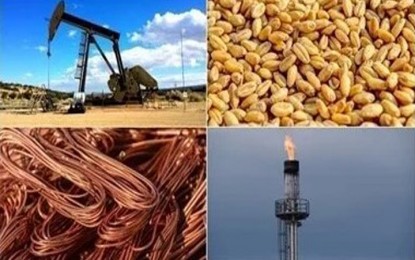
ISTANBUL – The volatility in the commodity market increased and wavelength in the prices lengthened after major central banks delivered rate hikes.
It was also noteworthy that product-based divergence rose last week while the commodities followed a mixed course.
While investors focused on central banks, busy macroeconomic calendar and companies' balance sheets last week, mixed signals made it difficult for markets to find direction.
In the commodity market, which had a mixed course last week, the wavelength increased even more after the monetary policy decisions of the US Federal Reserve (Fed) and the European Central Bank (ECB).
The Fed last week raised interest rates once again by 25 basis points. This was its 10th rate hike in just over a year, carrying the target range for the federal funds rate to between 5 percent and 5.25 percent — its highest since August 2007.
Fed Chair Jerome Powell said inflation has "moderated somewhat" since mid-2022 but "pressures run high."
The ECB also delivered a 25 basis points rate hike last week against the high inflation pressures.
The rate on the main refinancing operations and rates on the marginal lending facility and the deposit facility were increased to 3.75 percent, 4 percent, and 3.25 percent, respectively.
The inflation outlook continues to be "too high for too long," the ECB said in a statement.
Concerns that the economic activity in China might start to slowdown weighed down commodity market last week.
Last week's the final purchasing managers’ index (PMI) data showed that the euro area manufacturing activity in April has posted the fastest deterioration since May 2020.
Hamburg Commercial Bank's eurozone manufacturing PMI was revised slightly higher to 45.8 in April, from the preliminary flash data of 45.5, according to a report by the US-based financial services company S&P Global.
Precious metals followed a mixed course last week as gold and silver gained 1.4 percent and 2.5 percent, respectively, while palladium and platinum fell 0.7 percent and 1.4 percent, respectively.
In the over-the-counter market, copper ticked down 1.1 percent, lead by 1.8 percent, aluminum by 1.9 percent and zinc by 1.2 percent, on the other hand nickel climbed 3.8 percent.
Last week, Brent oil lost 6.2 percent and natural gas traded on the New York Mercantile Exchange fell 11.3 percent.
Weak economic data from China led the decline in oil prices. The Caixin China General Manufacturing PMI surprisingly decreased to 49.5 in April from 50 in March, bucking market forecasts amid an ongoing property downturn and fears of a global slowdown.
Agricultural commodities were on a high note last week, fueled by expectations that Fed could cut interest rates by 50 basis points until the end of the year.
Traded on the Chicago Mercantile Exchange, wheat rose 4.2 percent, corn 2.1 percent, soybeans 1.2 percent and rice 3.9 percent last week.
In the Intercontinental Exchange (ICE), cotton climbed 4 percent coffee 1.1 percent and cocoa 0.1 percent, while sugar lost 3.2 percent. (Anadolu)
